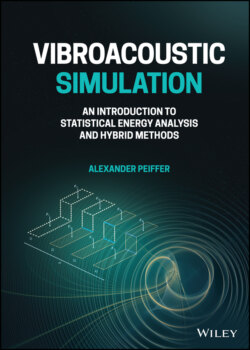Читать книгу Vibroacoustic Simulation - Alexander Peiffer - Страница 45
1.6.2 System Response in Time Domain
ОглавлениеThe product of Fourier transforms corresponds to a convolution in time domain (1.42), hence:
(1.174)
or alternatively, as
(1.175)
A system is called causal (and this is definitely the case for any mechanical system) when the impulse response is zero at times smaller than zero (it can only react when it has experienced an excitation), so
(1.176)
That means we can rearrange the integration limits as follows:
(1.177)
All those forms are convolution integrals according to (1.46) and the response can be written as
(1.178)
So, with this function we can express any response of a linear system using the above convolution integral. When considering a unit frequency excitation F(ω)=1 Equation (1.173) shows that the response equals the transfer function.
(1.179)
The inverse Fourier transform of the unit spectrum ejωt0=1 for t0=0 is the delta function δ(t) according to (1.32). In the time domain this reads as the following convolution integral
(1.180)
We see that the transfer function in time domain is the response of the system to a delta function. Consequently, this function is called the impulse response of the system. When we calculate the inverse Fourier transform of the frequency response function of the damped harmonic oscillator we get as impulse response function
(1.181)
This is the solution of the following equation of motion
(1.182)
which corresponds to the solution of the homogeneous version in (1.1) for the following initial conditions
(1.183)
Finally, with the definition of system response functions in time and frequency domain, there is a powerful description available. This will be used in Section 1.6.3 in order to describe the system response to random signals.
